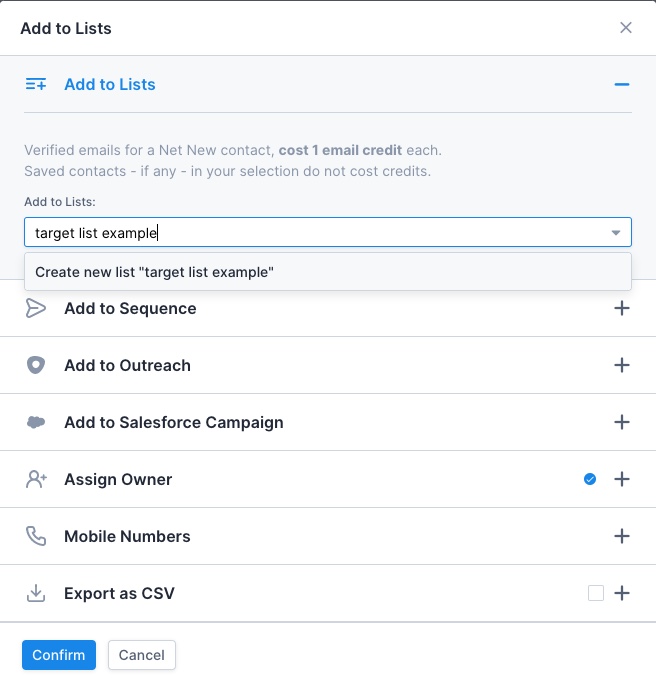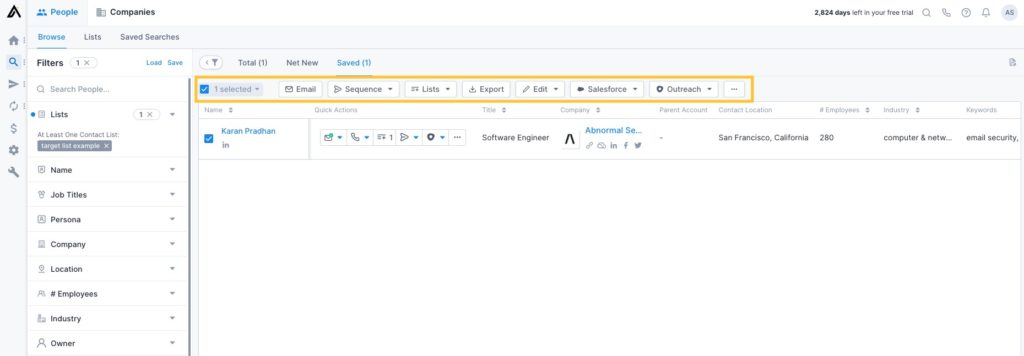How to Create a Target List in Apollo.io
Apollo can help you transform your target list from a list of names to a living and active index, capable of endless automated action. Here's how to find and create a target list of your highest-value prospects.
by
Karli Stone
PUBLISHED Nov 9, 2023
5 Min Read
You're wasting time and resources chasing leads that'll never convert. Every sales team faces the same challenge — too many potential prospects, not enough hours in the day, and pressure to hit increasingly ambitious targets. The solution isn't working harder; it's working smarter with a focused target account list.
If you're like most B2B sales teams, you've probably experienced the frustration of scattered efforts. Your SDRs are reaching out to anyone with a pulse, your marketing team is casting too wide a net, and your conversion rates are suffering. This is exactly why the most successful revenue teams build strategic target account lists — and why we're going to show you how to build yours in Apollo.
In this guide, we'll walk you through what a target account list actually is (beyond the buzzwords), why it's critical for sales success, and most importantly, how to build and manage one effectively using Apollo's platform. You'll learn practical tips for identifying high-value accounts and get step-by-step instructions for creating your list in Apollo — complete with screenshots and real examples.
What is a target account list?
Let's start with the basics. A target account list (or TAL) is a curated list of high-value companies that your sales and marketing teams have identified as perfect-fit customers. Instead of casting a wide, inefficient net, you're focusing all your energy on the accounts most likely to buy your product and succeed with it.
Think of it as your go-to-market wishlist. These are the prospects that match your ideal customer profile (ICP) to a T, and they're the ones your team should prioritize for all outbound and account-based marketing (ABM) efforts. It's about working smarter, not harder.
Why target account lists matter for B2B sales success
Building a TAL isn't just busy work — it's a strategic move that pays off. When your teams have a clear, shared list of priority accounts, you unlock some serious advantages:
- Laser-focused efficiency: Your reps stop wasting time on low-potential leads and concentrate their efforts where it counts. This means more meaningful conversations and less spinning their wheels.
- Tighter sales and marketing alignment: When both teams work from the same list, their efforts are perfectly in sync. Marketing warms up the accounts with targeted campaigns, and sales follows up with personalized outreach. No more arguments about lead quality.
- Higher conversion rates and ROI: Because you're targeting companies that are a great fit for your solution, you'll naturally see better engagement, higher conversion rates, and a much stronger return on your sales and marketing investment.
Tips for identifying and building your target list
1. Leverage Firmographic and Technographic Data
There is no such thing as a target account list that is too personalized.
Ensuring that your target list is tailored to your exact needs means gathering and utilizing firmographic and technographic company data.
Access to a B2B data source (like Apollo!), can ensure that your target account list mirrors your ideal customer profile. You can identify your leads using advanced filters such as:
- Company size
- Technologies used
- Job postings
- Revenue and funding
- # of employees by department
2. Use Intent Data to Find In-Market Buyers
Company data is a great resource, but it is best combined with intent data to give you some real-time insight.
Intent data is information collected about a web user's behavior - specifically web content consumption. It is a set of signals that reveals which leads or accounts are actively researching on first and/or third-party sites.
Basically: it shows you exactly which companies are in your target market.
Leveraging real-time intent data can give you a huge competitive advantage. Once you see an account or contact is showing signs of purchase intent, add them to your target list! Chances are, this method will maximize your conversion rates.
3. Set Up Job Alerts
Keeping an updated target account list means identifying potential business early.
Subscribe to job change alerts using your buyer personas' titles and other keywords and get notified whenever potential customers are in a new role and looking to update their technology stack.
4. Implement Tiers to Target Lists
An important part of having a usable target list is keeping it organized. Tiering your list of ideal accounts will allow you to sort through your lists based on specific campaigns that you are running.
Allow us to elaborate…
Account tiering is a process of customer segmentation. It refers to separating prospective buyers into different groups based on a common characteristic. For creating target lists, most sales and marketing teams find it most useful to use a three-tiered system:
- Tier 1 accounts are considered perfect ICP fits. They should be similar to your highest-value accounts, the customers who receive the most benefit from your product or service. Tier 1 accounts should get the "full" account-based marketing efforts from your sales reps and marketers.
- Tier 2 accounts are strong ICP fits, but have a lower lifetime value. They may not get completely customized marketing plans, but they are accounts that still deserve a good amount of relevant touches.
- Tier 3 accounts are your lowest priority accounts in your target list. They are accounts that are still worthwhile to target, but don't deserve a high amount of resources for customization and personalization.
This is just one, more popular example of how you can tier your target lists to work for you.
Tiering your target lists does require some front-loaded work, but ultimately it will increase the usability of your lists by tenfold.
Subscribe for weekly updates
Creating your first target list in Apollo
Creating Target Lists
When you're prospecting in the Apollo database and using the dozens of advanced filters to hone in on your ideal customer profile, your Apollo search page could look a little something like this:

When you select a contact or account, buttons will appear at the top bar that allows you to take an action on them. If you select the 'list' button, you'll be able to add them to any list.

From the modal that appears, you'll be able to select a list that already exists or, in this case, create your new target list.

To learn more about adding the right person to a new list, check out this helpful video.
Managing Target Lists
To manage and/or edit your target list, head to the People > List. This will bring you to a page containing all of your lists, including the target list you just created, for you to filter and search through:

This page is especially helpful once you've created more than one target list and wish to manage them all in one place with ease. And by clicking the "..." button under Actions, you can edit and/or delete any one of your target lists instantly.
Now, the great thing about creating these lists with Apollo is the endless sales automation and enrichment features that come along with it.
When you're inside your list, there will be a toolbar at the top:

Select any contact(s) within your list to:
- Instantly send them an email
- Add them into a sales sequence
- Import them into Salesforce, Outreach, and/or CSV
- Add/remove them from other lists
- Set a contact stage
- Assign them to an owner and/or account
- Set a custom field
- Enrich email addresses and mobile numbers
- Merge duplicate contacts
- And so much more
Apollo not only helps you hone in on your target accounts, but takes your whole prospect list and transforms it into a living and active index, capable of endless automated action.
Start building smarter target lists today
The theory is great, but the results are in the execution. With the right data and tools, you can stop guessing and start building target account lists that fill your pipeline with high-quality opportunities. Apollo gives you the data, filters, and automation you need to build and act on your lists from a single platform.
The right prospects are out there waiting. Get started with Apollo for free today and build a target list that drives real revenue.
Frequently asked questions about target account lists
What's the difference between target accounts and a target account list?
Target accounts are the individual companies you want to sell to. A target account list is the organized, prioritized collection of all those companies that your sales and marketing teams will focus on for a specific period or campaign.
How many accounts should I include in my target list?
It depends on your team's size and resources. A good rule of thumb is to focus on a manageable number that allows for genuine personalization. An SDR might only be able to handle 50-100 active accounts at a time, while a larger team could manage several hundred. Start smaller and expand as you refine your process.
How often should I update my target account list?
Your TAL shouldn't be static. We recommend reviewing and refreshing it at least quarterly. Companies' needs change, new buying signals emerge (like funding or hiring for key roles), and you'll want your list to reflect the most current opportunities.
Can I create multiple target lists for different campaigns?
Absolutely. In fact, it's a great practice. You might have one list for a campaign targeting a new industry vertical, another for a win-back campaign, and a third for upselling existing customers. Using a platform like Apollo makes it easy to create and manage multiple lists.
What's the difference between a target account list and a regular prospect list?
A prospect list can be any list of potential buyers. A target account list is a highly strategic, prioritized subset of those prospects. It's built around your ICP and represents the accounts with the highest potential value, which receive the most focused and personalized attention from your team.
Related articles
Subscribe for weekly updates
Receive insider stories and data-backed insights for elevating your work and staying ahead of the curve
You can unsubscribe at any time using the link in our emails. For more details, review our privacy policy.